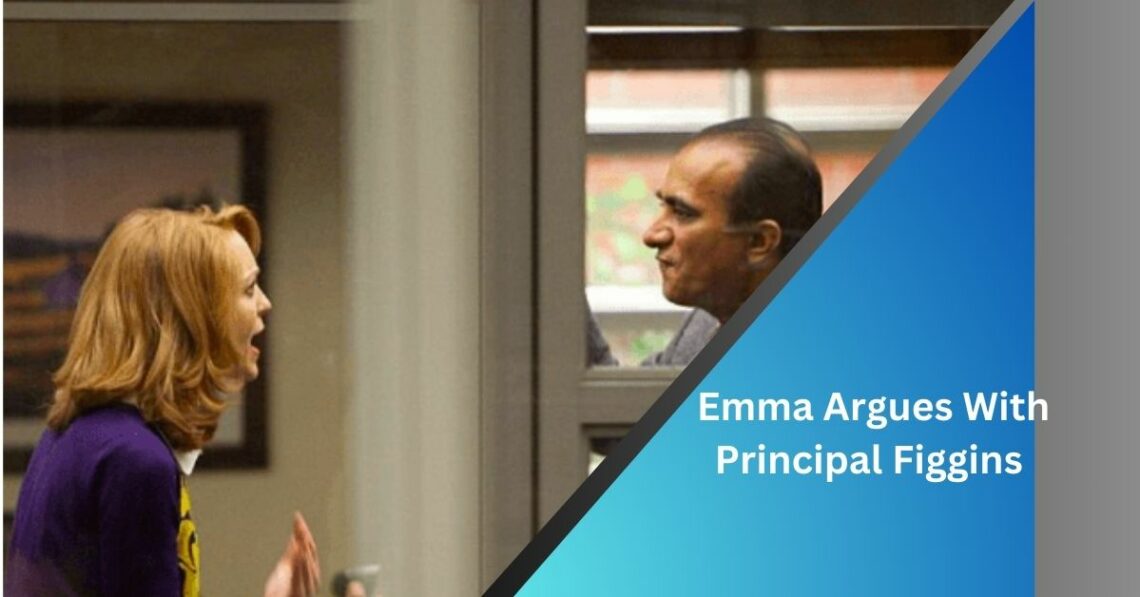
Emma Argues With Principal Figgins – Her Untold Story!
Emma fearlessly challenges the status quo, engaging in a passionate argument with Principal Figgins. This real-life tale unfolds a student’s quest for self-expression and stands as a testament to the power of advocating for personal values within the school environment.
Emma talks with Principal Figgins because they don’t agree on school rules. Emma thinks the rules stop students from being themselves. She wants to make the school a better and more inclusive place for everyone.
Let’s explore how Emma challenges school policies, sparking a clash of ideals with Principal Figgins. Discover the positive journey of advocacy and resolution in this compelling tale.
Why Did Emma And Principal Figgins Argue? – Have A Look!
The argument between Emma and Principal Figgins was sparked by specific school policies that Emma found restrictive and stifling. Emma’s passion and dedication stem from her belief in the need for positive change within the educational environment.

By challenging these policies, she aims to create a more inclusive and empowering atmosphere for students, emphasizing individual expression and a better learning experience.
When Did The Clash Occur? – Crassh Chronicles!
The clash between Emma and Principal Figgins occurred during a series of events marked by disagreements over school policies. The timeline highlights moments when tensions escalated, leading to confrontations between Emma’s advocacy for change and Principal Figgins’ commitment to existing rules.

Despite the clash, positive outcomes emerged as the confrontation became a catalyst for transforming and improving the educational environment. This timeline showcases the evolution of the argument and its impact on positive change within the school.
Why Emma Opposes School Policies? – Unveiling The Motivations For Change!

- Motivation Behind Opposition: Emma’s fervent opposition to school policies is motivated by a deep commitment to student well-being, self-expression, and equality.
- Dedication to Student Well-being: Emma believes that certain policies may negatively affect the well-being of students, prompting her to challenge and seek improvements.
- Advocacy for Self-Expression: Central to Emma’s stance is the idea that these policies restrict students’ ability to express themselves individually.
- Focus on Equality: She advocates for changes to create a more equal and inclusive environment within the school, addressing concerns related to fairness and equal treatment.
- Positive Impact on the Student Body: Emma’s advocacy aims for a positive impact on the entire student body, fostering an atmosphere that appreciates and celebrates the unique qualities of each student.
Read Also: CARLA DIAB – LET’S DISCOVER LIFE IN 2024!
The School Policy In Question – Navigating Brighter Future!
Dress Code Dilemma:
At the core of the clash were specific school policies, notably the dress code. Emma’s opposition stemmed from her belief that the dress code stifled self-expression and individuality among students.

Cell Phones and Educational Tools:
Another policy in question was the restriction on cell phone use during school hours. While Principal Figgins emphasized the need for a distraction-free environment, Emma saw the potential educational benefits of smartphones as tools for learning, research, and communication among students.
Emma’s Positive Perspective:
Emma’s standpoint was inherently positive, advocating for self-expression, student empowerment, and a broader view of education that incorporates modern tools and methods.
Benefits of Revisiting Policies:
The argument sheds light on the potential benefits of revisiting and revising policies. Emma’s perspective suggested that a more inclusive and supportive environment could be fostered by adapting policies to accommodate the evolving needs and preferences of students.
Principal Figgins’ Defense – Maintaining Order And Equality!
Order and Equality:
Principal Figgins staunchly defended the existing policies, emphasizing their role in maintaining order and equality within the school. His viewpoint centred on creating a safe and equitable learning environment for all students.

Legal Compliance:
Figgins explained that the policies were designed to align with legal requirements, specifically aimed at protecting transgender students from discrimination and bullying. This demonstrated his commitment to adhering to legal standards and fostering an environment where all students feel accepted.
Positive Intentions:
Principal Figgins’ defence revealed positive intentions, driven by the belief that clear guidelines contribute to a positive learning environment. His commitment to inclusivity and understanding diversity from an early age was evident in his advocacy for policies that support transgender students.
Balancing Act:
The crux of Figgins’ viewpoint lies in balancing the need for order and discipline with the recognition of individual freedoms. While acknowledging the potential educational benefits of certain tools and expressions, he sought a middle ground to ensure a conducive learning environment.
Read Also: BCPS SCHOOLOGY – TRANSFORM EDUCATION WITH INNOVATION!
How Did The Argument Unfold – Unveiling A Narrative Of Transformation!
The argument between Emma and Principal Figgins unfolded as a dynamic clash of contrasting perspectives on school policies. Throughout the confrontation, Emma’s courage and determination became evident, injecting a positive energy into the discourse.

Despite the inherent tension, moments of constructive dialogue emerged, providing a platform for both parties to express their viewpoints. These exchanges created opportunities for understanding and compromise, showcasing the potential for collaborative problem-solving.
Positive actions also emerged during the argument, underlining the transformative change that Emma’s proactive approach and advocacy could bring about.
The unfolding of the argument thus became a narrative of resilience in the face of adversity, portraying Emma as a driving force for positive transformation within the school environment.
Lessons Learned – Analyzing Both Sides!
- Diverse Perspectives: The clash between Emma and Principal Figgins provided valuable lessons in considering diverse perspectives. Both sides presented valid points, showcasing the importance of acknowledging different viewpoints within the school community.
- Constructive Dialogue: A key takeaway is the power of constructive dialogue. Despite differences, Emma and Principal Figgins engaged in a discourse that allowed them to understand each other’s viewpoints. This emphasizes the significance of open communication in addressing conflicts.
- Potential for Growth: The lessons learned extend to the potential for growth. By actively listening to each other and finding common ground, there is an opportunity for positive change. The clash becomes a catalyst for improvements that benefit the entire school community.
- Balancing Individuality and Order: The clash underscored the delicate balance between individuality and order in a school setting. Understanding this balance can lead to policies that foster self-expression while maintaining a conducive learning environment.
Read Also: COLE CAMERON LEINART – UNVEILING LIFE AND LEGACY!
Possible Compromises And Solutions – Embrace collaboration!
Collaborative Compromises:
The clash prompted Emma and Principal Figgins to explore collaborative compromises. Both parties engaged in discussions to find a middle ground, showcasing the power of teamwork in resolving conflicts.

Balancing Policies:
A positive outcome was the consideration of policy modifications that strike a balance. This involved revisiting existing policies, ensuring they promote individuality while maintaining essential guidelines for a thriving school environment.
Student Involvement:
The clash emphasized the positive impact of involving students in decision-making processes. Creating opportunities for student input ensures policies align with their needs and aspirations, fostering a sense of ownership and responsibility.
Open Dialogue:
Another key aspect was the encouragement of open dialogue. Emma and Principal Figgins demonstrated the benefits of transparent communication, paving the way for understanding, compromise, and, ultimately, positive solutions.
Frequently Asked Question:
1. Why is Emma arguing with Principal Figgins?
Emma’s argument stems from her strong advocacy for positive changes in certain school policies. She believes in reshaping these policies to better serve the well-being, self-expression, and equality of students.
2. What school policies are at the centre of the argument?
The argument focuses on policies such as dress codes and restrictions on cell phone usage. Emma sees these policies as potential hindrances to self-expression and empowerment, prompting the need for reassessment.
3. How did the clash unfold between Emma and Principal Figgins?
The clash developed over time, with key events leading to confrontation. Despite the clash, positive outcomes emerged, transforming the argument into a catalyst for constructive dialogue and potential positive change.
4. What lessons can be learned from analyzing both sides of the argument?
Reflecting on both Emma and Principal Figgins’ perspectives reveals the importance of considering diverse viewpoints and finding common ground. Positive growth and change can result from engaging in constructive dialogue and understanding different perspectives.
Conclusion:
The clash between Emma and Principal Figgins reflects a passionate pursuit of positive change in school policies. This dynamic narrative emphasizes the importance of diverse perspectives, constructive dialogue, and finding common ground for a more inclusive educational environment.
Read Also:
- TIFFANY PESCI AGE – A COMPLETE JOURNEY!
- GEORGIS NIKOLOS – A MARITIME JOURNEY OF LEGACY AND INNOVATION!
You May Also Like

Ventura Craiglist – Your Ultimate Guide To Dynamic Marketplace!
January 18, 2024
6 Benefits of Working With a Trust Management Company
February 28, 2024

